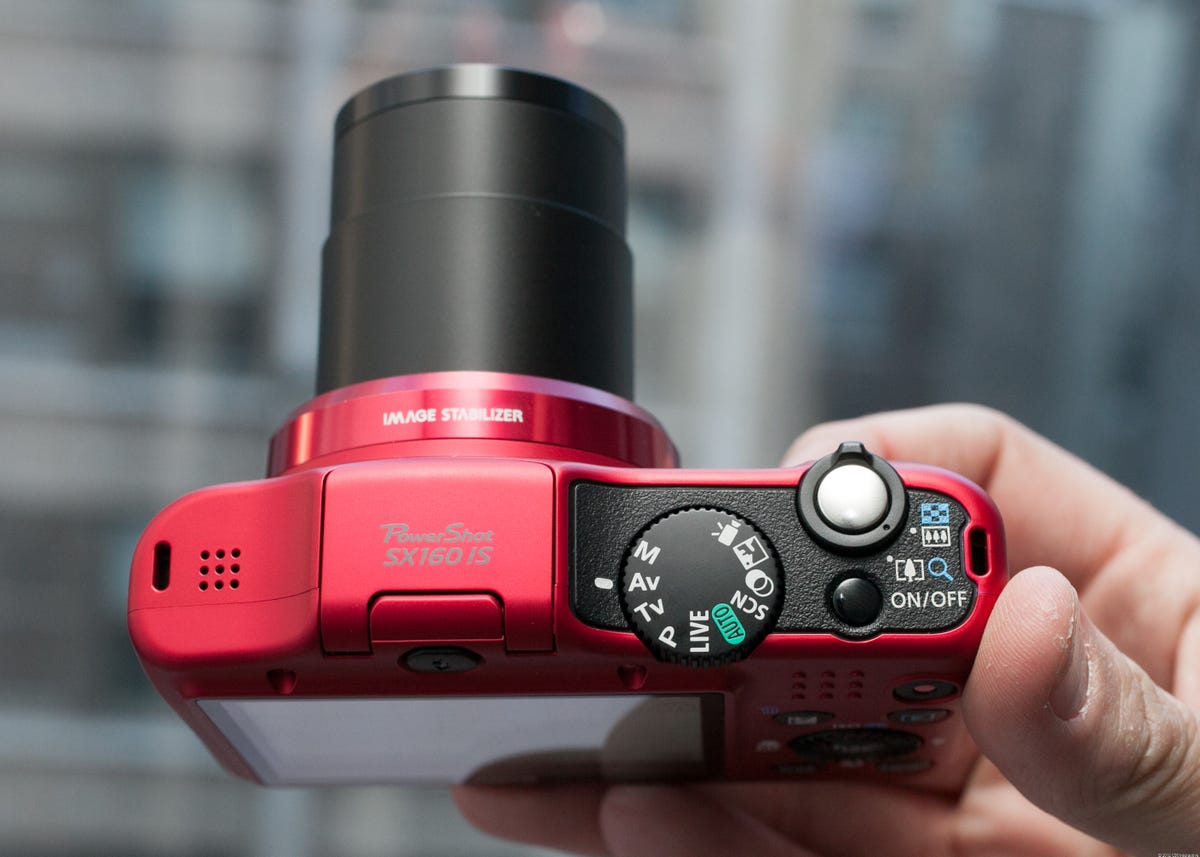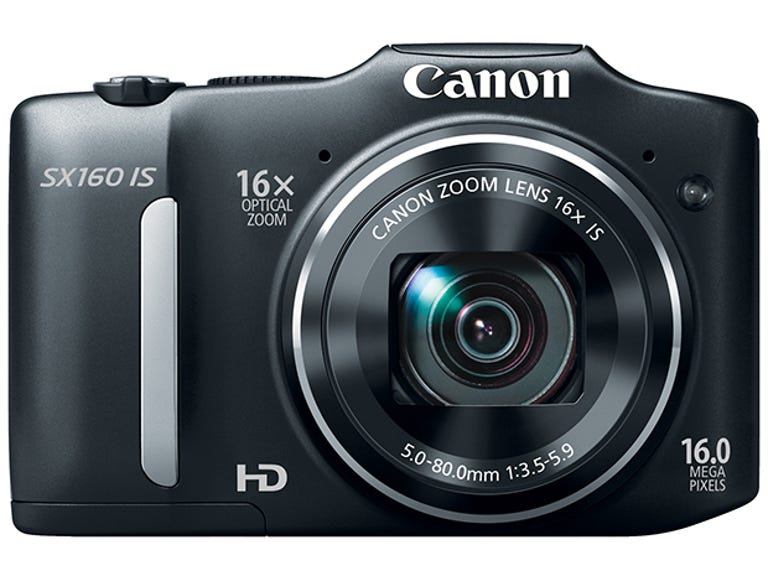 Why You Can Trust CNET
Why You Can Trust CNET Canon PowerShot SX160 IS review: Good choice for beginners on a budget
If you like manual controls and AA batteries, this camera is one to consider.
The Canon PowerShot SX160 IS is not for everyone. It's big and bulky. It doesn't have the best shooting performance or image quality. And it certainly doesn't have all the latest and greatest features found in many of Canon's higher-end PowerShots.
The Good
The Bad
The Bottom Line
But, here's why I like it. For about $150 ($80 less than its original price), you get a competent point-and-shoot camera that does more than just automatic snapshots. That makes it a nice fit for those who want to learn more about controlling shutter speed and aperture without a big investment. Its 16x zoom lens with image stabilization gives you some good framing flexibility. And although some might prefer a high-power rechargeable battery, the SX160 IS' two AA batteries make it very convenient when traveling or for infrequent photographers.
The more expensive Canon PowerShot SX260 HS is a better choice if you can afford it, getting you improved photo and video quality and faster performance. Otherwise, this is a good option for beginners or casual photographers or just anyone looking to take nicer photos than a smartphone can deliver.
Picture quality:
Though you probably won't want to use its photos at full size, the SX160 IS overall produces very nice photos, especially for its price and features. Pixel peepers will see noise even at ISO 100, but it's not noticeable at reduced sizes. Up at ISO 400 is where it starts to be more visible.
Going above that you'll start to see more color noise, artifacts, and loss of detail. The camera stops at ISO 1600, which is really fine since I can't imagine a higher sensitivity getting usable results. The camera definitely favors dropping shutter speed over raising ISO when left in auto. That's good in general, but if you're not paying attention it could result in blurry photos.
Video quality is very good, too, but as with its photos, you'll see more noise the less light you have. The lens does zoom while recording and when it's zooming in you will hear some motor sound picked up by the stereo mics in front in quieter scenes. Overall, though, if you just need to capture the occasional clip for Web sharing, it does a fine job.
Shooting performance:
Editors' note: We recently updated our testing methodology to provide slightly more real-world performance information, so the results aren't necessarily comparable with previous testing. Until we're finished refining our procedures, we will not be posting comparative performance charts.
One of the big drawbacks of the SX160's predecessors was shooting performance; all of them have been pretty slow on all accounts. This model gets a much-needed new autofocus (AF) system. Canon says algorithm improvements, lighter lens elements, a stronger lens motor, and reductions in processing and AF scan times all result in faster focusing and less shutter lag. Being faster doesn't necessarily mean it's fast, but it is improved from the SX150 IS in some ways.

From off to first shot still takes about 2 seconds, which given the bigger lens is good. The shot-to-shot times averaged 1.4 seconds without the flash, though using the flash drove that wait time up to 7 seconds. Shutter lag -- the time from when the shutter release is pressed to when the image is captured without prefocusing -- was a minimum of 0.3 second in good lighting, and jumped to 0.7 second in low light.
There are two main continuous shooting options: one with autofocus on every shot and one that sets focus and exposure with the first shot. The latter is faster, capturing at about 0.8 frame per second. The continuous option with AF slows down to about 0.6fps. Add in the shutter lag for the first shot and you'll have to be pretty good at anticipating action to get the shot you want. Basically, don't buy this if you're regularly going to be shooting fast-moving subjects unless you're a good judge of timing.
Design and features:
The downsides to having a long zoom lens and AA batteries for power are size and weight. A camera needs room to hold a bigger lens and batteries (bigger than a lithium ion pack at least), and they make it heavier. That said, its bigger size does make it easier to handle despite the slight grip on the front, and the weight helps keep the camera a little steadier when shooting.
Plus, the bigger body also means room for larger, easier-to-press buttons. You get a one-touch movie record button in addition to display, menu, and exposure compensation buttons above and below the navigational scroll wheel to the right of the 3-inch LCD. The screen gets adequately bright, though some may still find it difficult to see in direct sunlight and it inverts when it's above eyeline.
The navigational wheel surrounds a Func./Set button and has top, bottom, left, and right pressure points for ISO sensitivity, focus (manual, normal, and macro), flash, and timer. The wheel is responsive with tactile stops to it, so you will not easily overshoot what you're trying to select. Its operation is overall easy to pick up, but even seasoned Canon users will want to examine the full manual included on the software disc bundled with the camera.
| Key specs | Canon PowerShot SX160 IS |
|---|---|
| Price (MSRP) | $229.99 |
| Dimensions (WHD) | 4.4x2.9x1.7 inches |
| Weight (with battery and media) | 10.3 ounces |
| Megapixels, image sensor size, type | 16 megapixels, 1/2.3-inch CCD |
| LCD size, resolution/viewfinder | 3-inch LCD, 230K dots/None |
| Lens (zoom, aperture, focal length) | 16x, f3.5-5.9, 28-448mm (35mm equivalent) |
| File format (still/video) | JPEG/H.264 AAC (.MOV) |
| Highest resolution size (still/video) | 4,608x3,456 pixels/ 1,280x720 pixels at 25fps |
| Image stabilization type | Optical and digital |
| Battery type, CIPA rated life | AA-size (two; alkaline included), 140 shots |
| Battery charged in camera | No |
| Storage media | SD/SDHC/SDXC |
The batteries and memory card slot are in a compartment accessed through the bottom of the camera, secured by a locking door. That's good considering there's nothing holding the batteries in place. On the right side of the body under a small door are a USB/AV port for connecting to a computer or external display and a Mini-HDMI port.
Battery life is very short if you use alkaline batteries at a CIPA-rated 140 shots. Using rechargeable NiMH batteries doubles that shot count, but keep in mind that using the zoom lens a lot, increasing screen brightness, recording movies, or continuous shooting all cut into that rated battery life. If you're going out shooting for the day, you'll want to bring spares or prepare to buy some along the way.
| General shooting options | Canon PowerShot SX160 IS |
|---|---|
| ISO sensitivity (full resolution) | Auto, 100, 200, 400, 800, 1600 |
| White balance | Auto, Daylight, Cloudy, Tungsten, Fluorescent, Fluorescent H, Flash, Custom |
| Recording modes | Auto, Program, Shutter-speed priority, Aperture priority, Manual, Scene, Live View Control, Creative Filters, Discreet, Movie |
| Focus modes | Face AF, Center AF, Macro, Normal, Infinity, Manual |
| Macro | 0.4 inch to 1.6 feet (Wide) |
| Metering modes | Multi, Center-weighted average, Spot |
| Color effects | Vivid, Vivid Blue, Vivid Green, Vivid Red, Neutral, Sepia, Black & White, Positive Film, Lighter Skin Tone, Darker Skin Tone, Custom (adjustment of contrast, sharpness, saturation, red, green, blue and skin tone are available) |
| Burst mode shot limit (full resolution) | Unlimited continuous |
Most point-and-shoots at this camera's price don't come with a large variety of shooting options or controls; they're mainly made for fully automatic shooting. Among the many modes on the SX160, however, are shutter-priority, aperture-priority, and manual. Available apertures at the wide end are f3.5, f4.0, f4.5, f5.0, f5.6, f6.3, f7.1, and f8.0; at telephoto you get f5.9, f7.1, and f8.0. Shutter speeds go from 15 seconds down to 1/3,200 second. If that's too much control for you, you can switch to Program and control everything but shutter speed and aperture.
Live View Control gives you simple sliders for adjusting brightness, color, and tone.
Of course, you'll also find Canon's reliable Smart Auto, which analyzes your subject and automatically selects an appropriate scene setting from 32 defined settings; some standard scene modes like Portrait, Landscape, and Fireworks; a Discreet mode that shuts off all noise and lights while shooting; and a Movie mode for capturing clips at resolutions up to 720p HD in MOV or iFrame formats.
For those who are addicted to the photo filters from a favorite smartphone app, Canon includes several of its high-quality Creative Filters: Fish-eye Effect, Miniature Effect, Toy Camera Effect, Monochrome, Super Vivid, and Poster Effect. Another mode, Live View Control, lets you easily experiment with exposure and color while seeing your results onscreen before you shoot (the same goes for the filters). While some may consider these gimmicks that can be done with software, they can be fun to play with if you're looking to do something different and can actually help you set up your shot appropriately for the effect you're after.
Conclusion:
The Canon PowerShot SX160 IS started out at about $230, but it's now down to $150, making it a very good value. For beginners on a budget or those just looking for a good occasional-use camera that you don't have to worry about charging first before shooting with it, it's a nice choice. However, a camera with a rechargeable battery pack will get you better performance and battery life and a lighter, smaller body. Also, the Canon PowerShot SX150 IS did produce better photos and is essentially the same camera, just a little slower with a little less zoom, and can be found for even less than the SX160 IS while it's still around.


